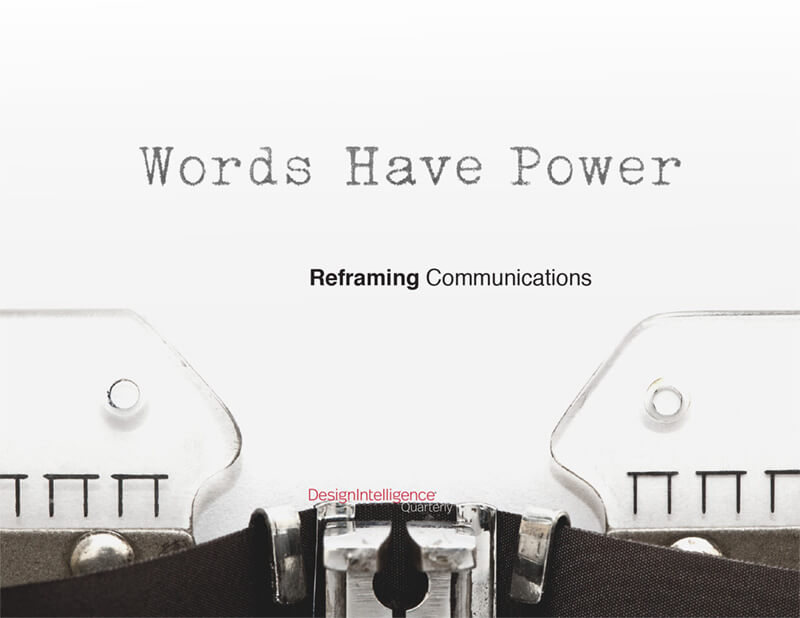Reframing Communications
by Chyenne Pastrana
Director of Marketing, DesignIntelligence
Words are more than words – they represent the dynamic shift from empathy to action.
As we struggle to navigate a sea of messaging during the Covid-19 centric world we are currently a part of – the true weight of words should not be ignored. With so much focus on information – and often -misinformation, marketers need to carefully craft timely messages that support and educate their core audiences. We are in the middle of a reframing in communication that is shifting from consumer-based, revenue-driven agendas to a focus on the emotional relationship between brand and customer.
The relationship between the marketer and the audience is crucial – we are all bound by the same current day limitations. With many of us operating in “survival mode”, the general public is trending towards loyalty and safety – they are unsure and emotional - and so are we. Customers want to hear from familiar brands. Brands they already have a relationship with. They want to know how companies are helping, not what they are selling.
Marketing & Communications
Norms Have Been Broken
When the pandemic first began taking form in the United States, companies’ messaging to their core audiences had to shift greatly and with absolute speed. As the nation entered shelter at home measures and a new lifestyle, brands needed to respond with compassion. Commercials, advertisements and emails quickly shifted tone from revenue generators to support systems. The general audience could no longer be “sold” in the same fashions they were just a week before. Products and services took the backseat and blank screens, thoughtful music, and words of support took the forefront. Phrases and sentiments like “During these uncertain times” and “we are in this together” began to flood advertising space. Many brands reacted quickly, showing their presence through comfort and charitable actions. Words brought comfort to their audiences while showing the brand was healthy enough to respond timely and directly. It felt good – we are all in this together, uncertainty became a communal feeling. Fast-forward a few weeks. While some still crave the support and charity-driven paths many companies are taking, some of the public is growing inpatient – yearning for clear direction and the ability to return to normalcy. But what is not clear is how companies can navigate this public divisiveness.

With a constantly changing audience – the need to respond quickly and thoughtfully is breaking the mold of tried and true marketing and communications models. We are being led by the virus, an invisible influencer that has marketers working double time without solid plans. How do we plan a campaign when the state of the nation has been a roller coaster ride for the last 10 weeks - with no solid end in sight? Even without the normal revenue-focused missions, the role of marketing and communications, is important to any brand’s health.

Unfortunately, according to estimates from a March 2020 survey of marketers conducted by the Interactive Advertising Bureau, nearly a quarter of all brands have gone dark, pausing their paid marketing communications for the first and second quarter of the year.
The world is watching – now is not the time to retreat and wait until it’s safe to reemerge. There is an opportunity not only to survive the fallout of this pandemic but to use it as a conduit for positive change.
New Models of Approaching
Consumer Communicatons
So, let’s think about the shift - is it time to ditch cookie-cutter planning and ROI-centric strategies and focus on breaking the barriers between brands and audiences? Many experts are beginning to cite a model that leads with consumer empathy and connectedness.
A recent Harvard Business Review article suggests that organizations follow the HEART framework of sustained crisis communication which consists of these strategies:
- Humanize your company
- Educate about change
- Assure stability
- Revolutionize offerings
- Tackle the future

This model and others like it bring the focus to connecting and empathizing with consumers through being clear, concise and thoughtful with your brand’s mission.
Companies now have the reason and the means to break the barriers and show we are all experiencing a similar story. Educate your audience to know how your brand is helping during this crisis. Empathize with them by letting your audience know how your brand is affected by the crisis. Offer something – free or discounted services, products, deliverables – or an offer in good faith to build consumer trust.
Given time, your brand’s stability and support during this crisis can turn into a new value proposition – by staying focused, connected, and genuine.
Chyenne Pastrana is the Director of Marketing for DesignIntelligence. Her focus is in brand development and creative direction. A native New Yorker, Chyenne studied at CUNY Queens College and Parsons School of Design before spending a bulk of her career in design and art direction for clients including: Bloomberg, Bloomberg Philanthropies, Metlife, W.P. Carey, Douglas Elliman and Assa Abloy.


